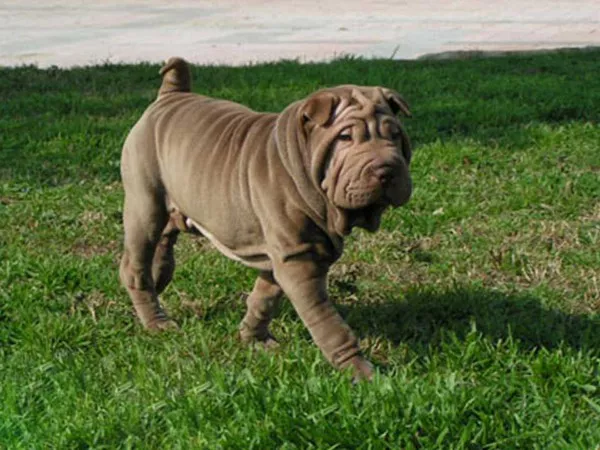Chinese Shar Pei dogs are undoubtedly intriguing and unique in their appearance, with their distinctive wrinkled skin and sturdy build. However, a common question that arises among potential dog owners and enthusiasts is whether these dogs are naturally aggressive. In this article, we delve into the temperament of Chinese Shar Pei dogs, exploring their characteristics and behaviors to determine whether the label of aggression is accurate or a misconception. By the end of this article, you’ll have a comprehensive understanding of what makes these dogs truly tick.
1.Origins and Historical Roles:
Delve into the breed’s history as a versatile working dog in ancient China.
Highlight their roles as hunters, herders, and guardians.
Discuss how their temperament was shaped by their original purposes.
2.Distinctive Traits That Spark Misconceptions:
Detail the unique physical features like the loose skin and “hippopotamus” face.
Explain how these traits might be misinterpreted as aggression by those unfamiliar with the breed.
Provide examples of how appearance doesn’t necessarily correlate with behavior.
3.Nature vs. Nurture:
Discuss the impact of genetics versus upbringing on a Shar Pei’s behavior.
Mention the importance of early socialization and training in shaping a dog’s demeanor.
Provide tips for potential Shar Pei owners to ensure a well-adjusted pet.
4.Protective Instincts:
Explain the Shar Pei’s natural protective instincts towards their families and territories.
Highlight the breed’s loyalty and willingness to guard their loved ones.
Provide anecdotes or case studies that showcase their protective behavior without aggression.
Potential Triggers and Mitigation:
5.Signs Your Dog May Be Becoming Aggressive
Aggressive behavior can occur in any dog and it is important to follow patterns of warning signs, such as:
- growl and snap
- Stiffness of the body and rapid wagging of the tail
- licking lips or yawning
- look away
- fluffed fur
- wince and tuck tail
- see the white of the eye
- Not all dogs exhibiting this behavior are generally aggressive, and many of these warning signs also indicate anxiety or fear.
6.Preventing Aggressive Behavior in Chinese Shar-Peis:
Aspect 1: Understanding the Underlying Triggers
Identifying Triggers: Aggressive behavior often stems from specific triggers. It could be fear, territorial instincts, or even past negative experiences. Observe your Shar-Pei closely to identify what situations or stimuli prompt aggressive reactions.
Body Language: Pay attention to your dog’s body language. Raised hackles, bared teeth, and a stiff posture might indicate potential aggression. By recognizing these signs, you can intervene before the situation escalates.
Aspect 2: Early Socialization for Lifelong Calmness
Puppy Socialization: The foundation for preventing aggression starts during puppyhood. Expose your Shar-Pei pup to various people, animals, and environments. This helps them develop positive associations and reduces the likelihood of fear-based aggression.
Positive Experiences: Ensure that these early interactions are positive. Reward your pup with treats, praise, and affection for calm and friendly behavior around new experiences. This sets the tone for a well-adjusted adult dog.
Ongoing Exposure: Socialization is not a one-time event. Regularly expose your Shar-Pei to new situations throughout their life to reinforce their confidence and adaptability.
Aspect 3: Positive Training Techniques
Positive Reinforcement: Positive reinforcement is a cornerstone of effective training. Reward desired behaviors, such as sitting calmly when encountering strangers, with treats and verbal praise. This creates a positive association with appropriate responses.
Redirecting Attention: Teach your Shar-Pei to focus on you in challenging situations. Use commands like “look” or “watch me” to divert their attention away from potential triggers. Reward them for complying.
Desensitization: Gradually expose your dog to situations that trigger aggression in controlled settings. Start at a distance where they remain calm and reward them for maintaining composure. Gradually decrease the distance over time.
Aspect 4: Professional Assistance
Consulting a Trainer: If your Shar-Pei’s aggressive tendencies persist or worsen, seeking the help of a professional dog trainer or behaviorist is a wise step. They can assess the situation, provide tailored strategies, and guide you through the training process.
Medical Assessment: Sometimes, underlying medical issues can contribute to aggressive behavior. Ensure your Shar-Pei receives regular check-ups to rule out any potential health concerns.
Conclusion:
In conclusion, while the label of aggression might be attached to Chinese Shar Pei dogs due to misconceptions and misinterpretations, a closer look reveals a breed that is inherently protective, loyal, and loving. As with any breed, responsible ownership, early socialization, and positive training play pivotal roles in shaping a Shar Pei’s temperament. By dispelling myths and understanding the breed’s true nature, potential owners can confidently welcome a Chinese Shar Pei into their homes, knowing they’re getting a faithful and remarkable companion.


